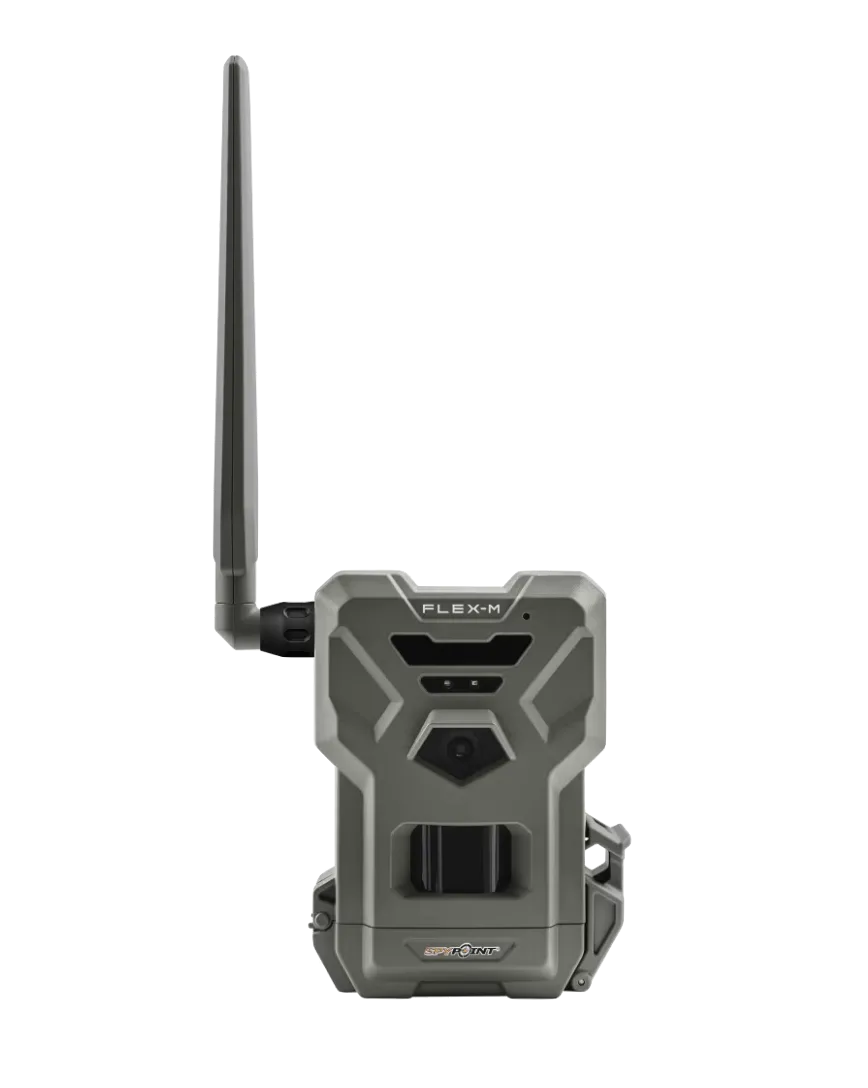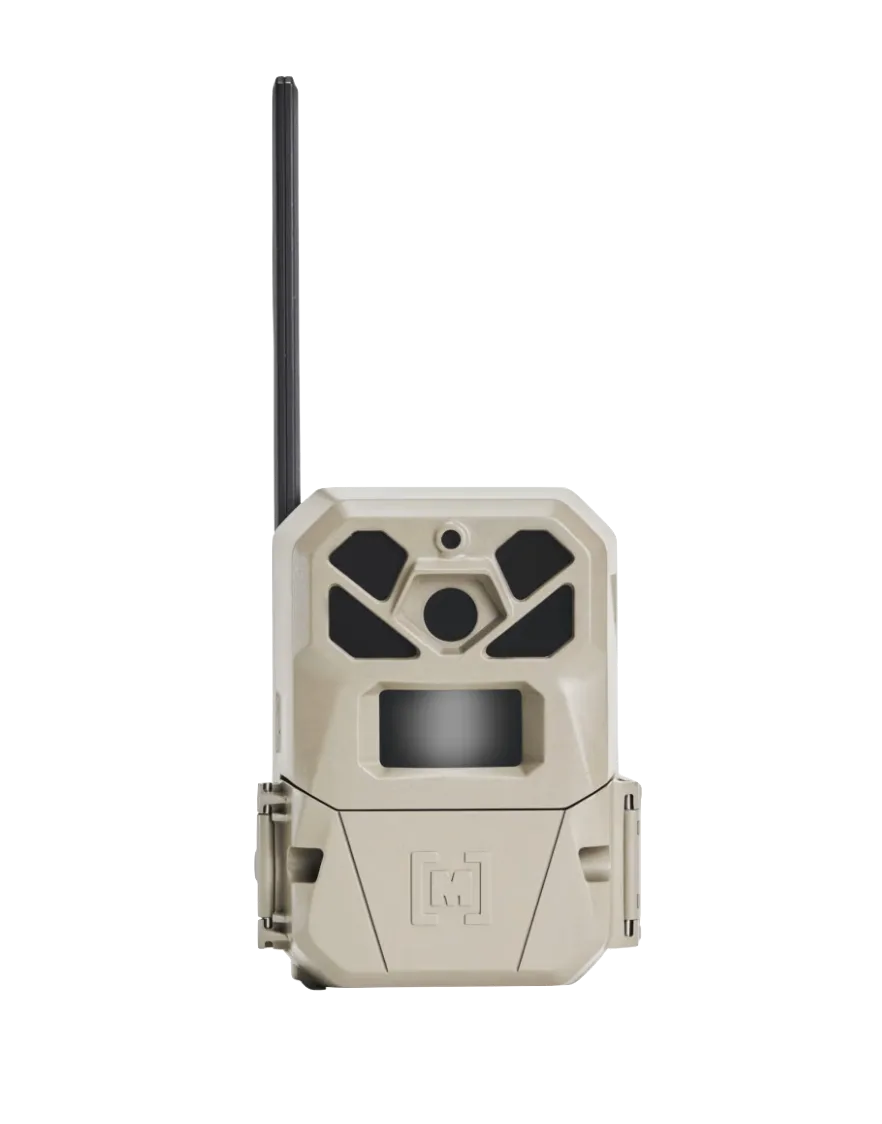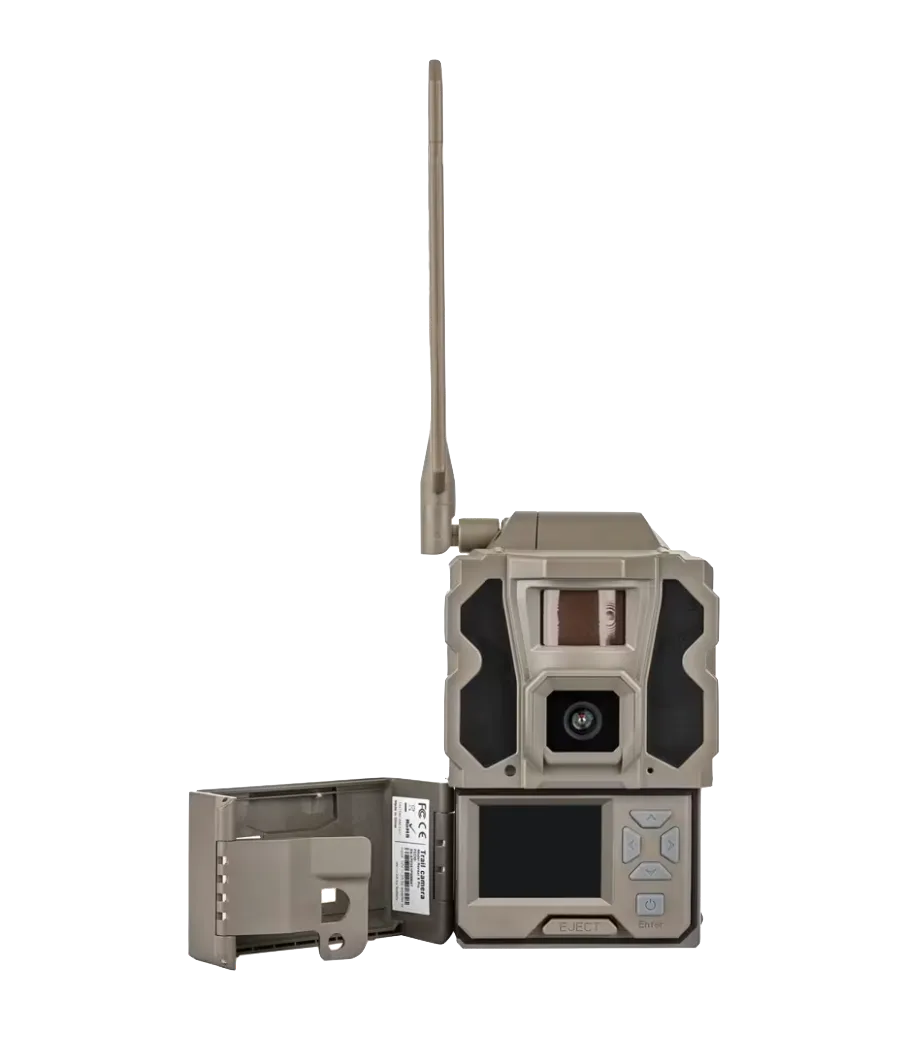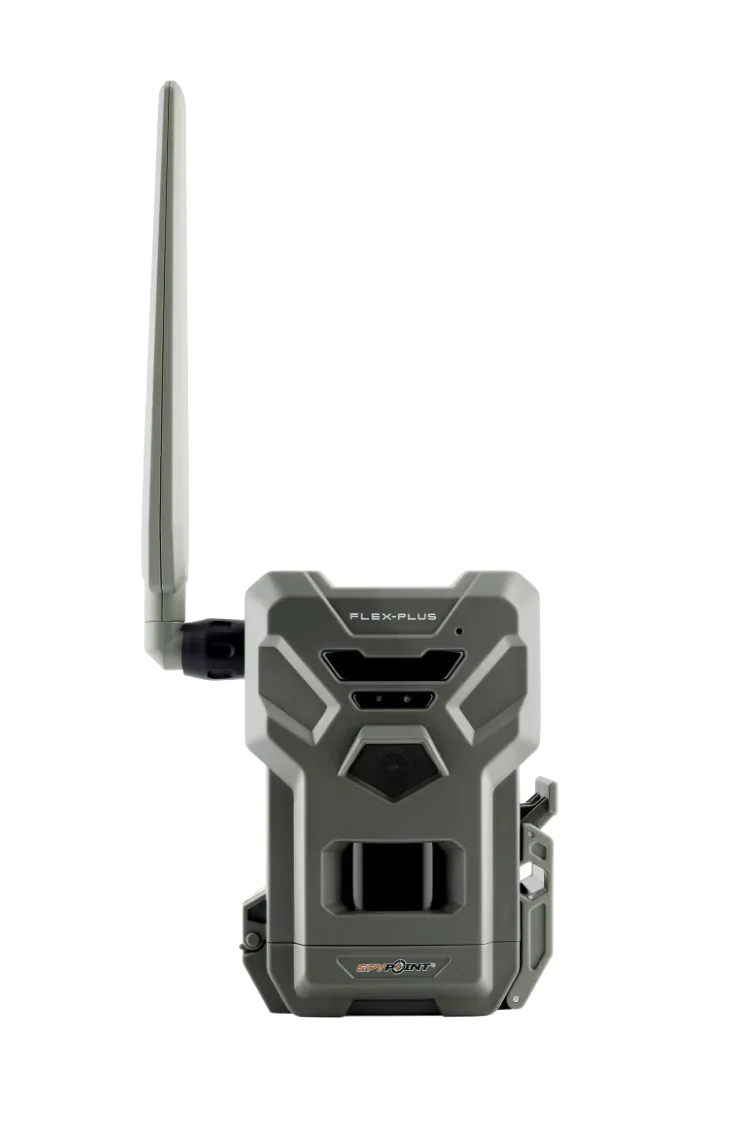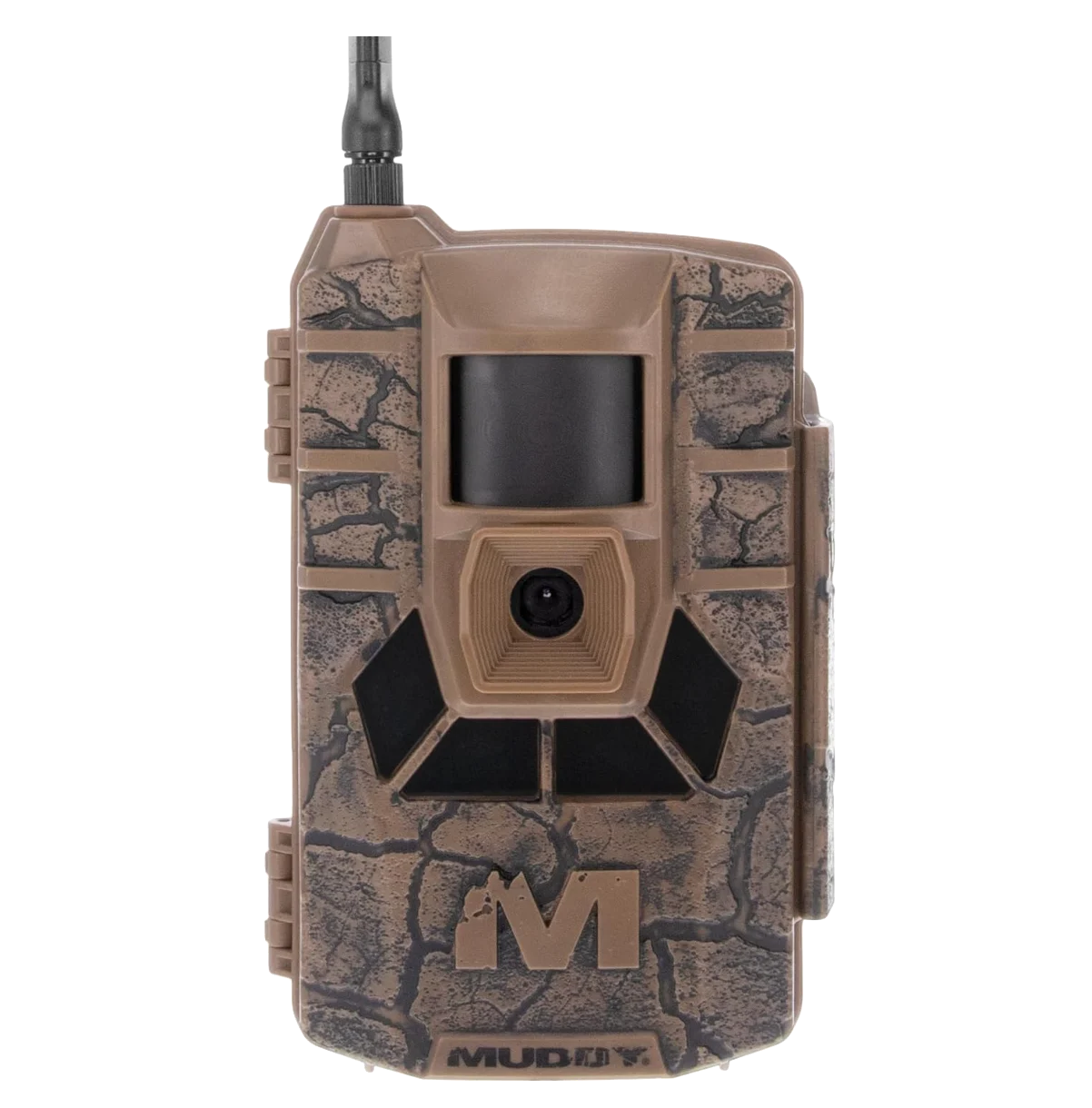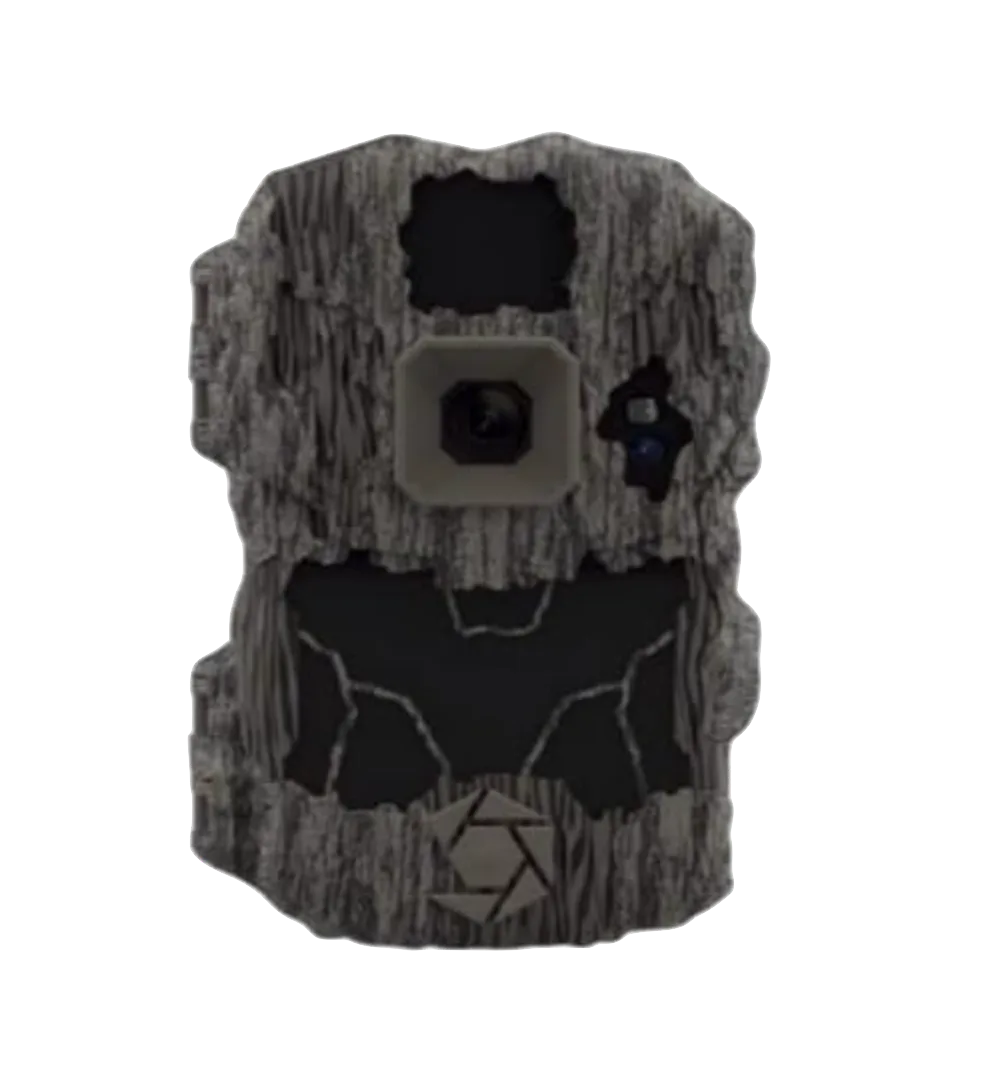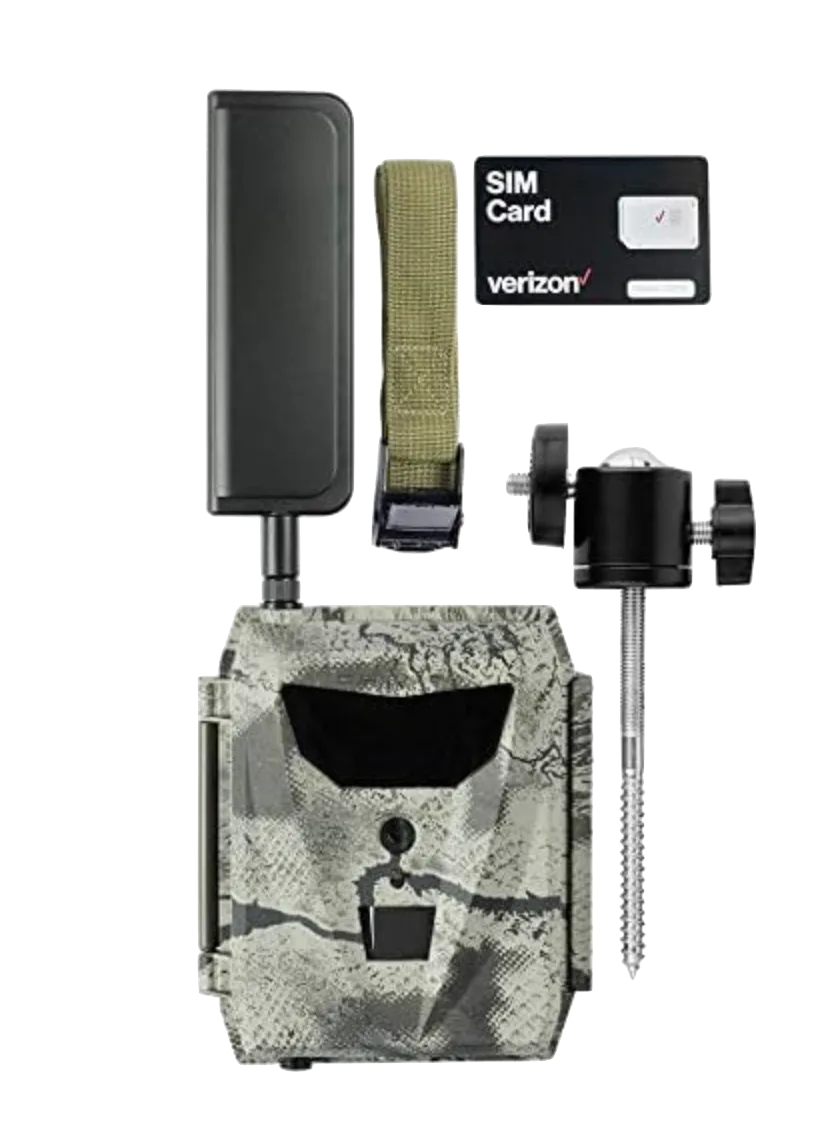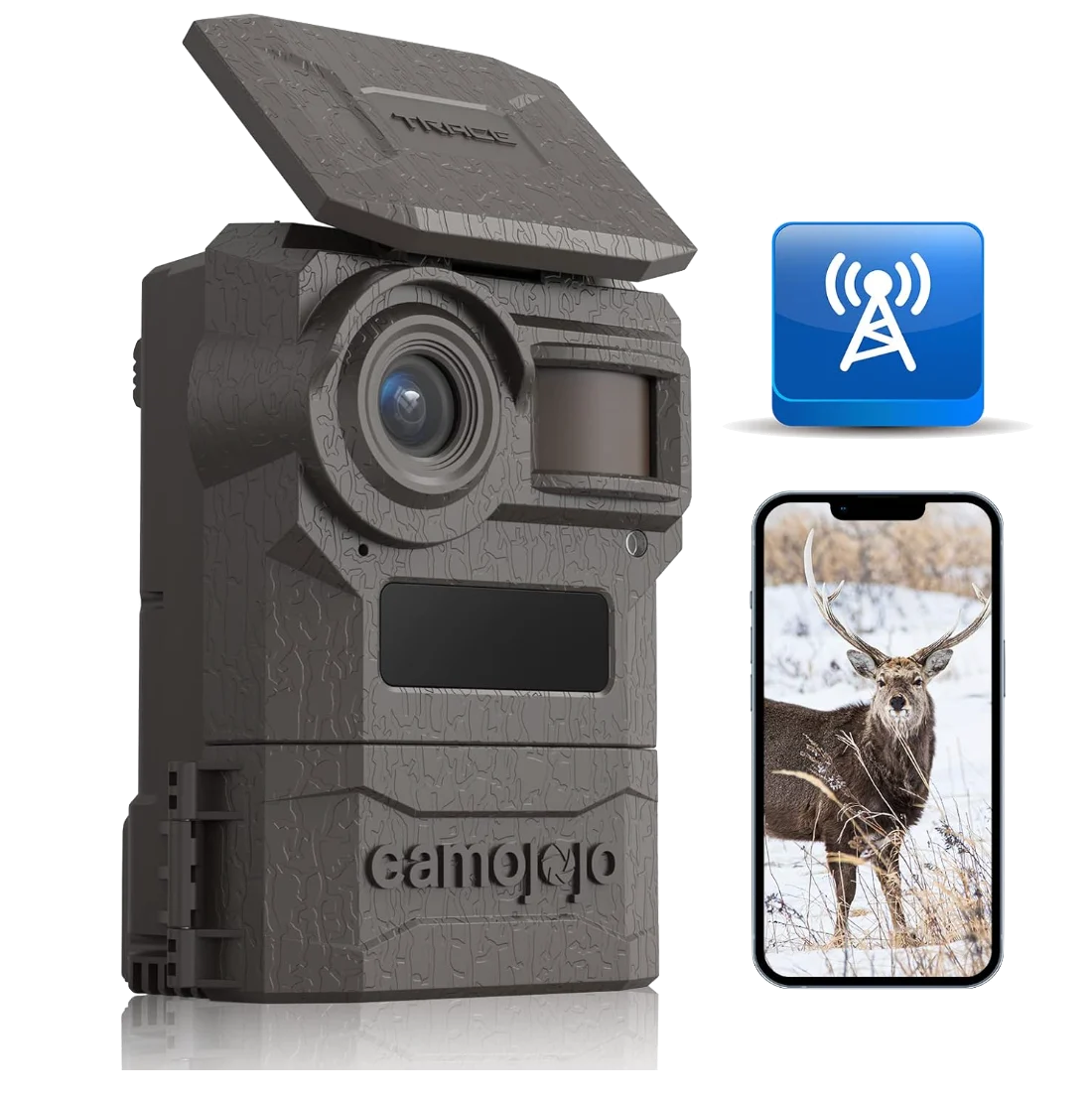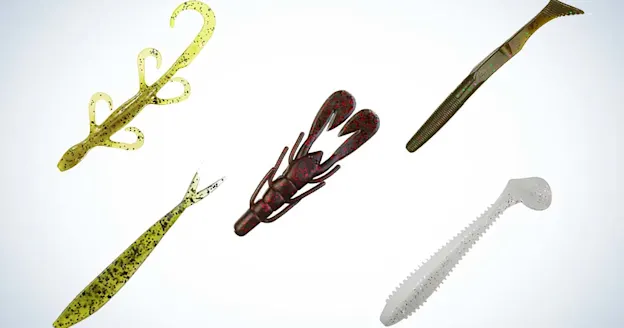We may earn revenue from the products available on this page and participate in affiliate programs. Learn more ›
There has never been a better time to buy a cellular trail camera. Today's hunters have more models than ever to choose from; the cameras themselves boast more features and better technology; connectivity between smartphones and cell cams gets more reliable and seamless by the day; and maybe best of all, prices have actually dropped, in some cases to below $100.
So, how do you decide which cell cams to buy when they all seem so good? That’s where we come in. We spent several months testing the latest cellular trail cameras ahead of this year’s hunting season to find the best. We evaluated them for their features, picture quality, price, and performance. What we found is good news for you: There are a lot of very good cell cams on the market. But in the end, several models rose to the top, and here they are—the best cellular trail cameras for 2024.
The Best Cellular Trail Cameras
Best Overall: Tactacam Reveal Pro 3.0
Best Detection Range: Spypoint Flex-Plus
Best Camera for Beginners: Moultrie Mobile Edge 2 Pro
Best Value: Spypoint Flex-M
The Rest of the Best
How We Tested Cellular Trail Cameras

The first thing we did when each camera arrived was evaluate how easy it was to get the unit set up with batteries, get it paired with a cellular plan, download the app, and get it sending photos to our phones. After that, we set all of the cameras up in a field marked with stakes every 25 feet out to 100 feet to conduct a walk-by test.
Over the course of several days and nights, we walked, jogged, and ran by the cameras out to the edge of their advertised detection range and beyond to test for things like comparative flash range, detection zone, and trigger speed. Then we redeployed the cameras on mock scrapes and deer feeders to give them a real-world test on wild game.

Throughout the test, we evaluated the cameras on construction, ease of setup, price, battery life, cellular performance, and camera performance. We also compared the quality of images we got from each camera, and noted any misfires or unacceptable images. (For more on each of the test categories see “What to Consider When Choosing a Cellular Trail Camera” below.) Finally, when all the tested and evaluating is done, we picked our winners and compile the lineup below.
Best Overall: Tactacam Reveal Pro 3.0

Specs
Trigger speed: Under .5 seconds
Detection range: 80 feet
Power: 12 AA Batteries, rechargeable pack, solar, or external 12V battery
Pros
Feature-rich design
High-quality screen
On-demand video
Cons
Chews through batteries
So-so nighttime photo quality
The user experience with Tactacam's Reveal Pro 3.0 is really over the top, to the point where I'd almost expect to pay double the price for everything you get. First is a high-quality, 2-inch, on-board screen that makes setting up the Reveal Pro 3.0 a cinch. It also displays cell signal, a few other quick stats, and lets you change settings directly on the camera (as opposed to only on the app). The antenna design is the best I’ve seen on a cellular trail camera to date. It stows for transport and is completely flexible—which is great for anybody worried about their camera antenna getting broken off by a critter or a limb on a windy day.
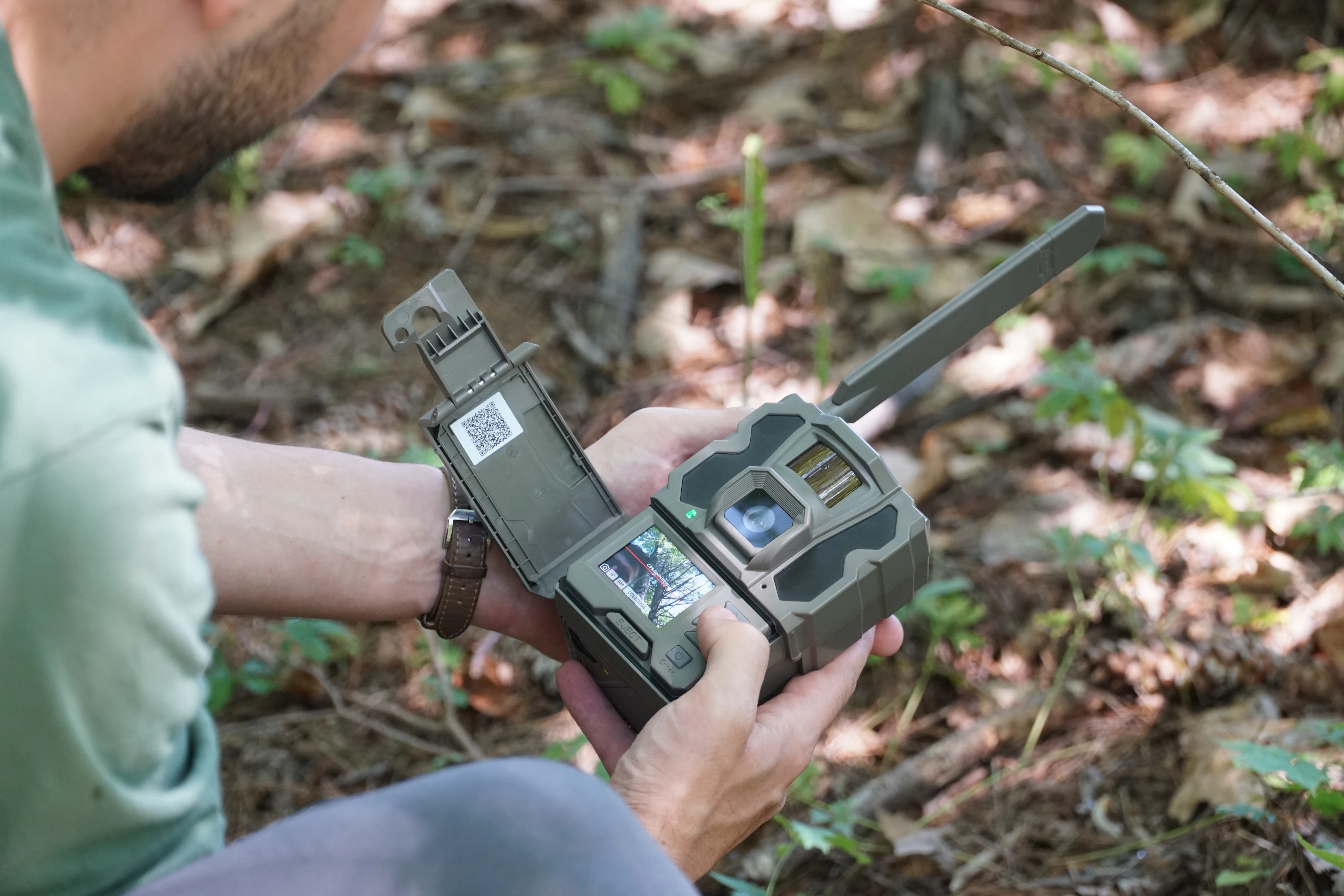
The app is excellent—easy to use and intuitive. After setting the camera up, I was receiving photos almost immediately. The nighttime photos on the Reveal Pro are good, but if you’re looking for better-than-good nighttime photos, you might want to look at the Reveal X 3.0 (below) which has a low-glow flash. The advantage of this camera's no-glow flash is that it's less apt to spook deer.
Picture quality was very good in all of the tests. I did get a few blurry images when running past the camera under different lighting conditions, which is expected. I also noticed the Reveal Pro was ripping through the alkaline batteries I used. That may have been due in part to so-so cell service, but so-so cell service is something most cell-cam users have to deal with, and the other cameras in the test didn’t have the same issue. In the end, though, the plusses far outweigh the minuses with this camera, given its excellent user experience, first-rare performance, and features like on-demand 1080p video, 4k image quality, and compatibility with other Tactacam parts, like rechargeable battery packs and tree mounts. Put it all together, and you're looking at our winner for Best Overall cell camera of 2024. —Matthew Every
Related: Read a full review of the Tactacam Reveal Pro 3.0 here.
Best Detection Range: Spypoint Flex-Plus
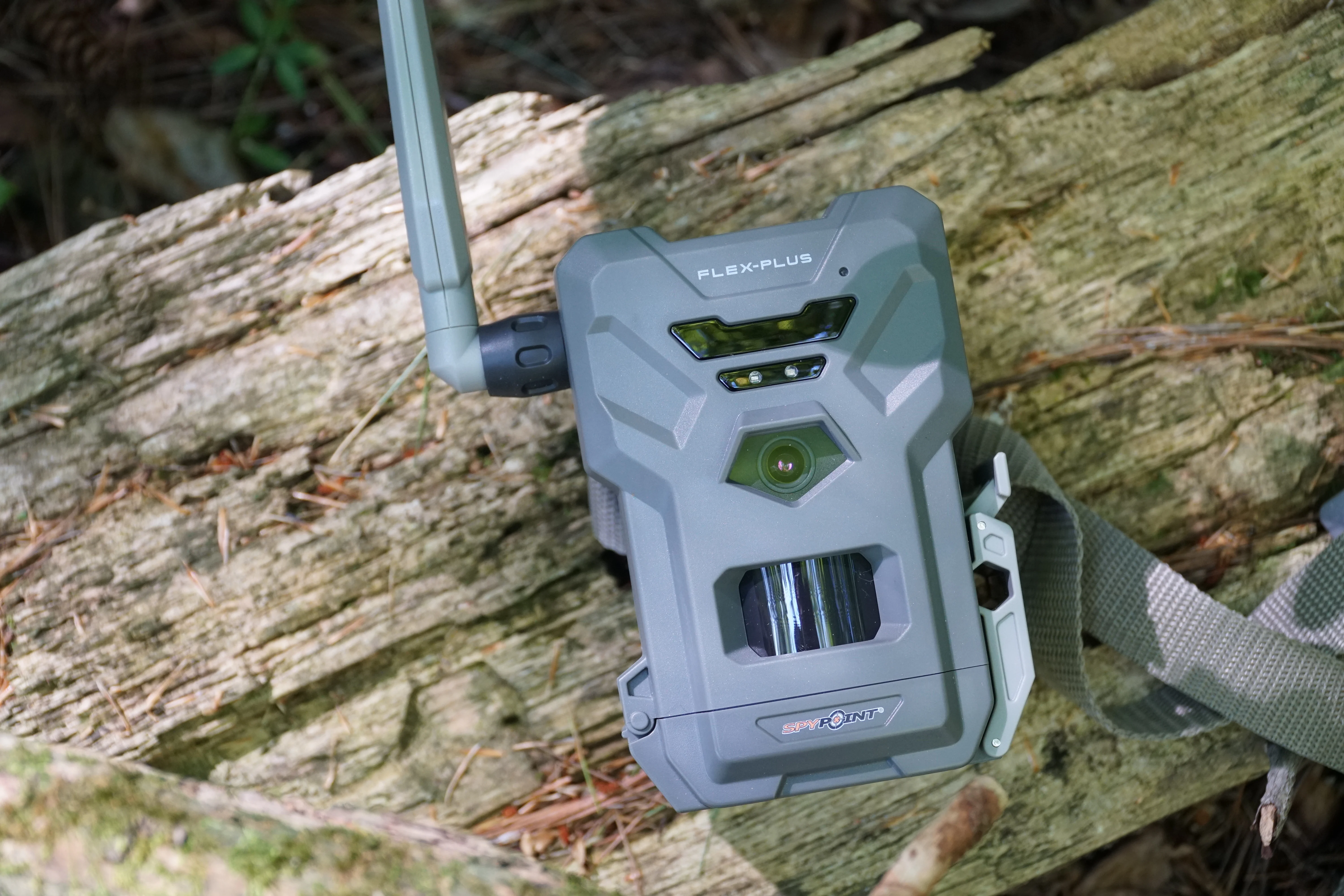
Specs
Trigger speed: .3 Seconds
Detection range: 100 feet
Power: 16AA Batteries
Pros
Fantastic detection range
On-demand video
Hybrid time-lapse/motion detection mode
Cons
Poor antennae design
Micro SD card
Tricky-to-use latch cover
Spypoint cameras continue to have great detection ranges and performance, and the Flex-Plus is no exception. New this year, the Flex-Plus triggered more quickly than many other cameras in our test and to ranges out to 100 feet. Out of the box, setup was pretty straightforward—only slightly less intuitive than with Tactacam and Moultrie, which were tops in this category. The Flex-Plus runs on 16AA batteries, which on one hand is a lot, but on the other, the camera runs for longer this way, which means fewer visits to the field to replace them.
The camera body has a removable antennae design, which leaves a bit to be desired. I would worry about it popping off never to be found again. The hinge-cover design is also frustrating to close, and you need to run the camera with a micro SD card, which is a little annoying. But with the bad out of the way, this camera still has a lot going for it.
First is value. The list price is $130, but you can find this camera for $99, which is steal. Second is performance. The lightning-quick trigger speed and huge detection range are not just great for the money, they're great compared to any camera in this test. The Flex-Plus also features on-demand video and photo through Instant Mode, which is a premium feature in a very budget-friendly package. You can also use a hybrid time-lapse function called Time Lapse+ that allows you to capture whole areas at set time intervals while still capture individual images when the camera detects motion.
On the walk-by, I got good, clean images at all times of the day and night at various ranges. I also found the app straightforward and easy to use. With good signal coverage at my deer feeder location, the Flex-Plus worked without a hitch. At the walk-by location, which had poor service, there was a bit of delay with some photos coming in. But that was far from a dealbreaker. If I were covering a big field in a location where I didn’t plan on moving my camera much, I’d take a hard look at the Flex-Plus. —M.E.
Best Camera for Beginners: Moultrie Mobile Edge 2 Pro
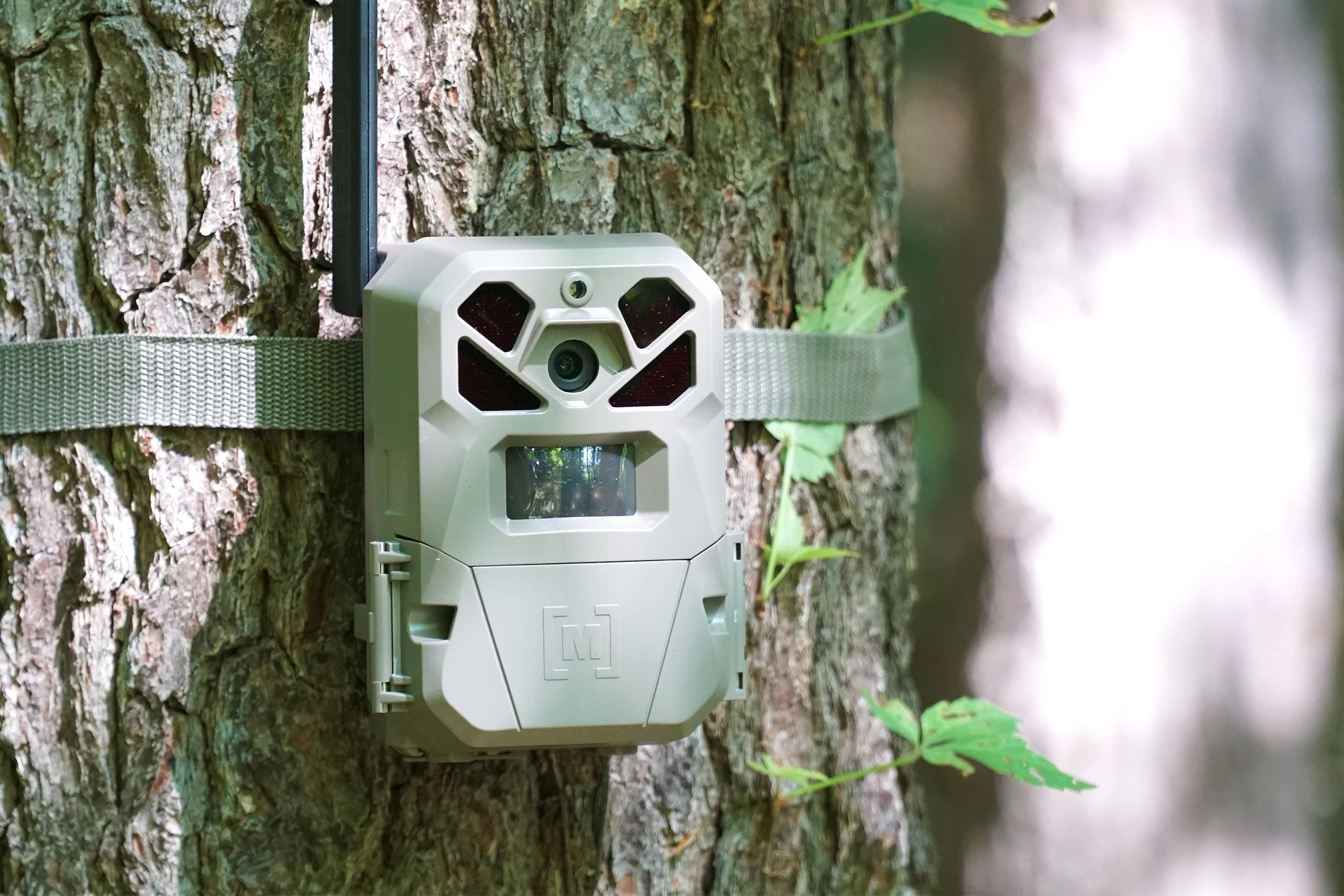
Specs
Trigger speed: .3 Seconds
Detection range: 100 feet
Power: 8-16 AA batteries, rechargeable battery pack, or solar
Pros
Sturdy body design sturdy
Extremely easy setup
On-board AI
Cons
No screen
Some blurred images
I may be a little biased here because I mostly run Moultrie Mobile trail cameras on my property, but I was happy to see that the Edge 2 Pro kept much of what I like about earlier versions of this camera. First is the body design. It’s clean, straightforward, and robust. I appreciate how you can flip down the antenna for easy transport, and I don’t need to worry about babying the camera through the woods.
This camera got the nod as best for beginners because of its easy setup. Once you scan the camera’s QR code, all you need to do is turn on the switch, and it does the rest. Under the camera’s latched cover, there is only an on/off switch and a few other necessary buttons—nothing that you don’t need. If you’re the kind of hunter who doesn’t want to spend hours obsessing over trail cameras, the Moultrie is hard to beat.
New with the Edge 2 Pro is a feature that lets you aim the camera using your phone’s screen and Bluetooth, which, during the test, worked great. Moultrie also sent along a slick rechargeable battery pack that replaces the AA tray and a mounting bracket for adjusting the camera to a tree. These accessories make the Edge 2 Pro even more user-friendly.
Moultrie has been using AI to separate animals you want to see from those you don’t, and this feature works well on the Edge 2 Pro. It’s great for hunters on a budget who can’t don't have an unlimited plan and therefore have a limited number of photos per month. As far as performance, I found it to be as advertised, and the Edge 2 Pro scored just above average compared to other cameras in the test. I found the trigger speed adequate and the 100-foot detection range to pick me up out to that distance. Plan prices are also average but not outrageous, although you do have a limited number of HD photos you can request with some plans. —M.E.
Best Value: Spypoint Flex-M

Specs
Trigger speed: .4 seconds
Detection range: 90 feet
Power: 8 AA batteries
Pros
Good detection range
Good quality photos
Fast Trigger Speed
Cons
Body/antennae design
Battery life
At $80, the Spypoint Flex-M rivals the cost of many non-cellular trail cams. Does that mean it's junk? Definitely not. You get a lot of the same great features you get with Spypoint’s Flex-Plus in this camera—the best of which is the Time-Lapse+ setting. The Flex-M runs on half the batteries of the Flex-Plus, which is a good or bad thing, depending on how you look at it. Personally, I like that I don’t need to load a pound of AAs into this camera, and with rechargeable batteries, it’s not a big deal. It also makes the camera more compact and lightweight for packing deep into the woods.
The trigger speed, detection range, and picture quality on the Flex-M punch way above its price. I felt that the images I got with the Flex-M were every bit as good, if not better, than some from more expensive cameras on this list. The colors are true to life and clear. And trigger speed and detection range worked as advertised with few blurry images and shots out to 90 feet.
The Flex-M’s body design is nice, but like the Flex-Plus, the antenna is a weak point. I also didn't like the micro SD card requirement, and the under-the-camera hinge cover isn’t ideal. Still, this thing is only 80 bucks. I’d take those knocks for the price because once the camera starts shooting, it captures fantastic images. Whether this is your first cellular trail camera or you’re looking to buy several to cover a large property, give the Flex-M a try. —M.E.
Related: Best Conventional Trail Cameras of 2024
Browning Defender Pro Scout Max HD
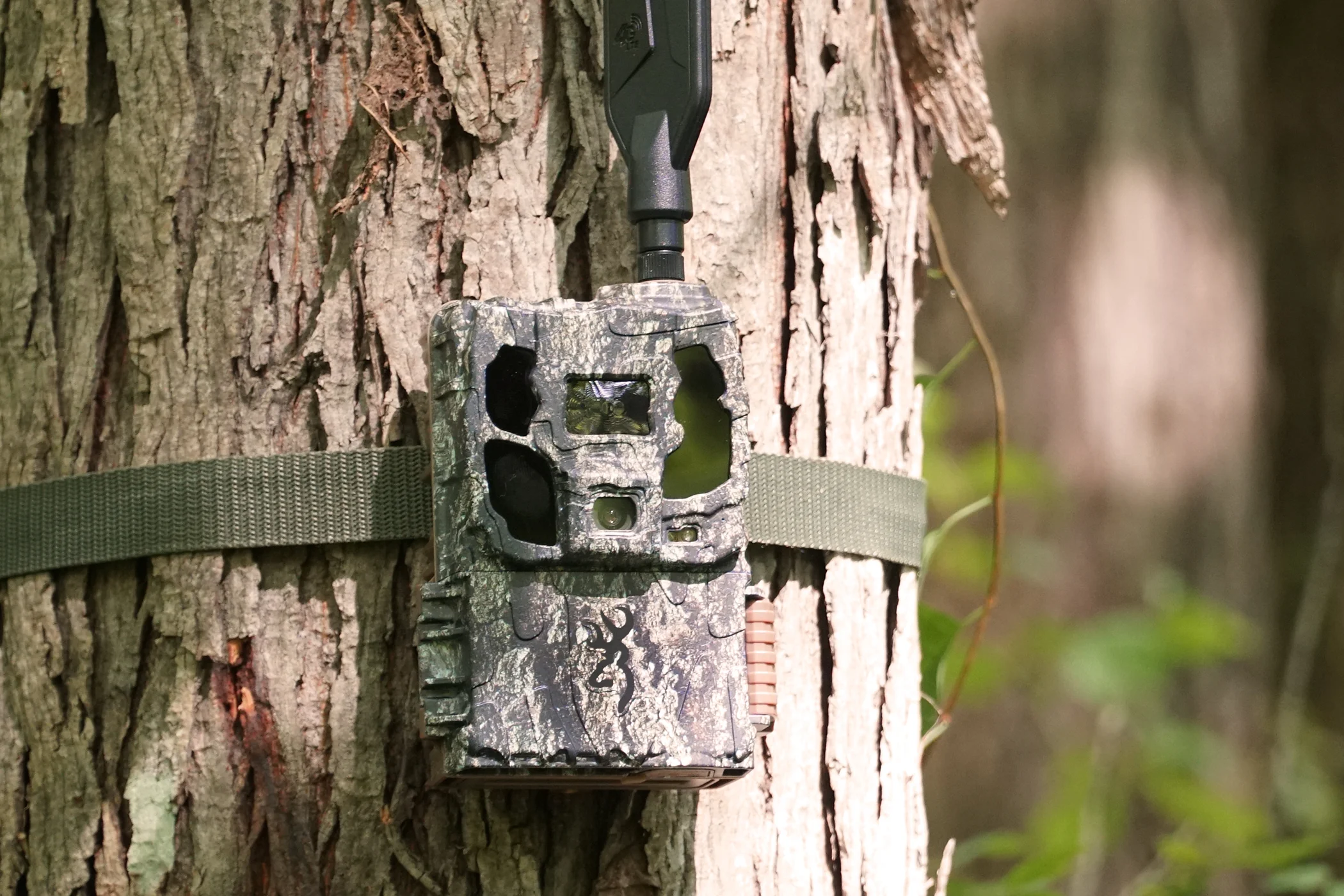
Specs
Trigger speed: .25 seconds
Detection range: 100 feet
Power: 8 AA batteries
Pros
Compact design
Fast detection
Bright Screen (no video)
Cons
Setup was tricky
Poor performance in low-reception area
The Browning Defender Pro Scout Max HD is a great camera that suffered a few setbacks during the test. But first I’ll tell you about the good stuff. The trigger speed and detection range for the Pro Scout Max HD is right there with the best cameras of the test. At night, on the run-by test, it froze me in the frame at 60 feet mid-stride. Daytime pictures were nice and bright, rich with color, and relatively easy to manage within the app.
Compared with the other cameras in the test, the app and interface were a little tricky. It took me some time to figure out that the QR code to register the camera was supposed to display on-screen and not the camera door. Browning does have a helpful video for setup, but it’s not as simple as turning the camera on and running out the door.
The body design on the Pro Scout Max is great, and it feels like the quality Browning trail cameras are known for. As for the antenna, I will say that I prefer one that stows away and is mounted on the side of the camera instead of the top, where moisture is more likely to collect. But I can ding the Browning for this, because it worked fine and I had no problems with it.
I spent half of the test in poor cell service, and the Pro Scout Max didn’t like it compared to the other cameras. The images were delayed, and sometimes I had to make sure it was working. I would still buy the Pro Scout Max, though, based on picture quality, trigger speed, and performance. And battery life, which is an important consideration given their cost these days. Browning claims the camera will have a 1-year battery life with just 8 AAs. Judging by other Browning cameras, I believe them. —M.E.
Reconyx HF2XC Hyperfire 2 Cellular (4G LTE)

Specs
Trigger speed: 0.2 seconds
Detection range: 75 feet
Power: 12 AA batteries
Pros
Fastest trigger on the market
Outstanding picture and video quality
Five-year warranty is the best in the business
Cons
Very expensive
Requires a dozen batteries
Doesn’t send video
If you’re a trail-camera person, you’ve definitely heard of Reconyx. This camera won our test last year, and though Reconyx hasn’t come out with a new version for 2024, I wanted to include it in the test as a benchmark. What you get with the Hyperfire 2 is raw performance. The image quality and lightning-fast trigger speed are as good as it gets. If you value that kind of performance above everything else, including price, this is the camera for you.
The price is the big hang-up for me with the Hyperfire 2. It costs $600. Compared to the latest and greatest body designs, it’s also starting to feel a bit dated. The camera does not have a door, rather the entire case hinges open. The antennae are also on the flimsy side. There is a brace that comes with the camera to keep them together, but I lost it almost immediately after taking it into the field. The case itself is very robust, but there are better case designs out there now.

I found the Reconyx app to be a bit cumbersome to use, too, though it is packed with information about each photo. Images that aren’t requested for HD come in grainy and pixelated. But once you download an HD photo, it’s better than everybody else's. For me, the Hyperfire 2 is a camera for someone who really loves taking high-quality pictures of critters. And for that, I think it really does have a place with outdoors people, or even more serious users like biologists and wildlife photographers. As a hunting tool, this camera is for someone who wants to spot kickers, split G2s, and broken-off tines on specific bucks. It that's your game, you can't do better than this camera. On the other hand, if you’re not that kind of deer hunter, you're probably better off buying more, cheaper cameras to cover a larger area and scout more efficiently. —M.E.
Tactacam Reveal X 3.0

Specs
Trigger speed: Under .5 seconds
Detection range: 96 feet
Power: 12 AA Batteries, rechargeable pack, solar, or external battery
Pros
Great value
Similar features to Pro 3.0 model
Good flash range
Cons
No screen
Battery life
The Reveal X 3.0 is the Reveal Pro 3.0’s little brother, and at $125, it's a great buy. Had the Spypoint Flex-M not been here, it would have won Best Value this year. The main differences between the Reveal Pro and the X are the lack of a screen, a low-glow flash, and a slightly different antenna design. (The antenna still flexes, just not as much as on the Pro.)
With the low-glow flash, the Reveal X got great nighttime pics and had a solid nighttime detection range during the test. As far as picture quality, it felt right there with other cameras in the mid-$100 price range. And just like the Pro, it shoots 4k photos and 1080p video. It also has 8GB of onboard memory, and you can run the camera with or without an SD card.

The downsides to the Reveal X are similar to the Reveal Pro. Battery life is a bit of an issue, though Tactacam does sell compatible solar panels. Without a screen, you also need to program via the app. One nice feature with both Tactacams is the ability to pair settings over Wifi, should you want to set your camera up at home before putting it out in the field. The Reveal X also has a live aiming feature, which lets you use your smartphone to aim the camera. Overall, this is a solid cellular trail camera that offers similar and better features than many competitors for less money. —M.E.
Muddy Matrix
Specs
Trigger speed: .40 seconds
Detection range: 80 feet
Power: 8 AA batteries
Pros
Very good picture and video quality
Great App
Affordable Plans
Good Value
Cons
Comparatively slow trigger speed
Comparatively small detection range
Test-camera connectivity issues
The Muddy Matrix has plenty of checkmarks on the plus side of the ledger, but also a couple minuses to consider. Picture and video quality are very good. Also, the Muddy app (which is basically the same as Stealth Cam’s, if you’re familiar with that one) has some very nice features; you can “train” the camera to select for species, times of day, even individual animals. Also, the camera has dual AT&T and Verizon SIM cards, and automatically selects the strongest signal in the area.
I have to report, however, that I had a heckuva time getting my test camera to achieve a solid signal connection. On the one hand, I live in an area where this can be a problem, and it may not have been the camera’s fault. On the other, no other camera struggled so mightily. Also, trigger speed is comparatively slow.
That said, I do very much appreciate what Muddy is doing to make the cell-cam game more affordable to get into. One factor that makes folks hesitate to get into the wireless game is cost, leading to the legitimate question: Is is worth it? Muddy is doing it best to make that answer “yes” by offering deals for multiple cameras purchased at the same time, and some very affordable data plans. If you’re ready to dive into the wireless pool and need multiple units, this is a solid option and value. —Scott Bestul
Stealth Cam DS4K Transmit
Specs
Trigger speed: .3 seconds
Detection range: 100 feet
Power: 12AA batteries
Pros
Quick trigger
Good detection range
Great housing
Simple setup and many programming options
Cons
Mediocre night pics
Higher price point

I love the speedy trigger on this Stealthcam trail cam, and the programming options are pretty incredible; four different video resolutions and camera MP options, as well as a burst mode that’s as good as any models (it’ll shoot up to 9 images per triggering event). I also found the camera easy to set up. While the night pics were less than stellar, that’s a small beef. The main beef is the price. Listed at just over $250, it cost almost twice as much as some newer cams with similar performance and features. That said, if you can find deals on this camera, and you won’t be disappointed.
Bushnell CelluCore 30 No-Glow
Specs
Trigger speed: 0.2 seconds
Detection range: 80 feet
Power: 12 AA batteries
Pros
Good trigger speed
Solid daytime pics
Internal screen viewer to aid setup
Among the most simple setups in the test
Cons
Fairly spendy in comparison
Night pics suffer a bit at longer ranges
Bushnell cameras have shown nothing but increased improvement in the last few years, and the CelluCore exemplifies that trend. The nice pics and easy setup are a huge plus for Bushnell. The impressive 0.2-second trigger speed helps capture sharp images and can keep up with fast-moving deer. Plus, the fast image recovery time recovery and subtle infrared flash elevate this cam to the next level. The only thing keeping this camera from the top models is a moderate detection range, and the data plans are, well, not much. It's not cheap either, though you may be able to find deals. —S.B.
Spartan GoCam Ghost
Specs
Trigger Speed: .4 seconds
Detection range: 60 feet
Power: 12AA batteries
Pros
First camera to offer live-streaming video
Great image/video quality
Rugged and durable housing and easy setup
Cons
Pretty average detection range and trigger speed
High price point
This is one of the best housing design around. In addition to being a cool-looking cam, the Spartan GoCam Ghost is rugged. It seems like it could get run over by a truck and keep snapping pics and shooting videos. The live-streaming option is decidedly cool for people who need MRI (most recent information) right now….though it may also raise eyebrows for those who question the ethics of trail cams in the first place. (I’m generally not one of them.) —S.B.
Camojojo Trace
Specs
Trigger speed: 0.25
Detection range: 100 feet
Power: 12 AA batteries
Pros
Easy setup
Impressive detection range
Great value
Cons
Picture and video quality decent, but no great
AT&T only
This camera generated a lot of buzz when it first hit the market last year as $100 cell cam that gets the job done. And the Camojojo does indeed do that. Setup was a breeze, picture quality decent, and I was especially impressed by the detection range. My test camera picked up a doe trotting pat at close to 150 feet, and it shot a perfectly acceptable video. I don’t think the Jojo merits its advertised .25 second trigger speed (which would put in the Browning/Reconyx class), but it’s impressively fast nonetheless.
Still, when you put the Camojojo head-to-head with the competition, you can see why it costs less. For one, the camera only comes with an AT&T SIM card, so users with Verizon (and other) carriers might be frustrated until they get this worked out. And while the pics and vids are perfectly fine for an entry-level camera, they are not quite as good as some cam costing only $20 or $30 more. Still, if you’re on a tight budget, have AT&T, and all you need is pics and vids good enough to show you generally what’s out there, the new Camojojo will do it. If you shop around, you can find this cam for around $100, and plans are very reasonable. —S.B.
What to Consider When Choosing a Cellular Trail Camera
Ease of Setup
Most cellular trail camera manufacturers have accepted the fact that not all their customers are 25 and were born with a smartphone in their hand, but some have not. Cellular cams should come with clear instructions and be easy to program and get running. All the cams I tested were run from an app where you set camera commands and settings, and where pics are sent. This is different than the original wireless cams, which typically sent images to the user via text (one of my buddies still refers to wireless cams as “texting cams” for this reason). How easily these apps set up, run, and monitor the camera is important.
Picture Quality
This can be tied into cost (as in, the more you spend, the better the pics), but not always. Trust me on this: After a while, the novelty of getting pics sent to your phone will wear off, and you’ll get irritated by blurred and grainy images. Some people are willing to give cell cams a pass on picture quality because they provide other benefits. I’m not one of them.
Trigger Speed
This is how long it takes the camera to snap a pic (or start shooting video) from when it detects movement. Generally speaking, the faster the better. One-fourth/second (0.25) is about as good as it gets, and a half-second is respectable for most camera setups. Anything much slower than that is decidedly ho-hum, and the camera better be darn good at something else.
Detection Range
This is the maximum distance at which a camera will “sense” a triggering object (hopefully a critter, but weeds and tree branches will also trigger it; something to keep in mind when setting cameras up). Again, as a rule, the greater the distance the better; the camera will get more pics of more animals.
Megapixels
I intentionally left this category out of my final evaluations, as it’s one of the most misunderstood features of trail cams. Manufacturers can exaggerate MP ratings through a process known as interpolation, which digitally adds megapixels to a photo without actually improving the picture. In other words, a 30 MP camera may not have any clearer or better pics than a 3 MP camera. The best way to judge the quality of a camera’s pics is to simply look at the pics.
App Quality and Bonus Features
A basic cell-cam app should make it easy for you to get the camera set up, change settings, and receive photos, but apps that make it especially easy to organize photos or identify trends to nail down daily patterns among the critters your monitoring can be a big plus. By the same token, little hardware extras, like mounts or brackets that help you aim the camera, are an important consideration, too.
The Best Cellular Trail Cameras of 2024—Final Thoughts
Best Overall: Tactacam Reveal Pro 3.0
Best Detection Range: Spypoint Flex-Plus
Best Camera for Beginners: Moultrie Mobile Edge 2 Pro
Best Value: Spypoint Flex-M
The Rest of the Best Cellular Trail Cameras of 2024
What impressed me most about this year’s crop of cell cams is how many really solid performers are now available for less than $150, including a couple threatening the C-note mark. Almost as important, these cams are getting even more user-friendly. While I sense that we’re a year or two away from the pinnacle of cell-cam performance, I also feel that waiting for things to get perfect is a big mistake. Today’s wireless cameras simply send more and better pics and videos than they ever have, and ignoring those capabilities will prevent you from enjoying some of the most scouting fun you might have all season. Shop wisely and the camera that perfectly fits your needs can be found in this year’s lineup.
Why Trust Us
For more than 125 years, Field & Stream has been providing readers with honest and authentic coverage of outdoor gear. Our writers and editors eat, sleep, and breathe the outdoors, and that passion comes through in our product reviews. You can count on F&S to keep you up to date on the best new gear. And when we write about a product—whether it’s a bass lure or a backpack—we cover the good and the bad, so you know exactly what to expect before you decide to make a purchase.



